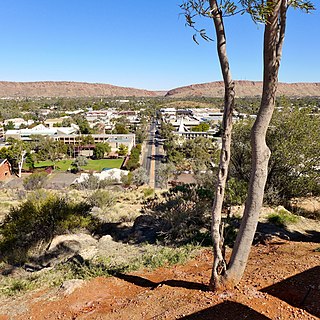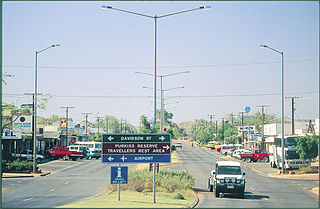
Darwin is the capital city of the Northern Territory, Australia. With a population of 139,902 at the 2021 census, the city contains most of the sparsely populated Northern Territory's residents. It is the smallest, wettest, and most northerly of the Australian capital cities and serves as the Top End's regional centre.

The Northern Territory is an Australian territory in the central and central northern regions of Australia. The Northern Territory shares its borders with Western Australia to the west, South Australia to the south, and Queensland to the east. To the north, the territory looks out to the Timor Sea, the Arafura Sea and the Gulf of Carpentaria, including Western New Guinea and other islands of the Indonesian archipelago.

Alice Springs is a town in the Northern Territory, Australia; the third largest settlement after Darwin and Palmerston. The name Alice Springs was given by surveyor William Whitfield Mills after Alice, Lady Todd, wife of the telegraph pioneer Sir Charles Todd. Known colloquially as "The Alice" or simply "Alice", the town is situated roughly in Australia's geographic centre. It is nearly equidistant from Adelaide and Darwin.

The World Solar Challenge (WSC), since 2013 named Bridgestone World Solar Challenge, is an international event for solar powered cars driving 3000 kilometres through the Australian outback.

The Ghan is an experiential tourism-oriented passenger train service that operates between the northern and southern coasts of Australia, through the cities of Adelaide, Alice Springs and Darwin on the Adelaide–Darwin rail corridor. Operated by Journey Beyond Rail Expeditions, its scheduled travelling time, including extended stops for passengers to do off-train tours, is 53 hours 15 minutes to travel the 2,979 kilometres (1,851 mi). The Ghan has been described as one of the world's great passenger trains.

The Adelaide–Darwin railway line is a railway line in Australia, between the South Australian town of Tarcoola and the Northern Territory city of Darwin. Preceded by a number of other shorter railways, a line through to Darwin was fully realised in 2004 when the final link from Alice Springs to Darwin was opened. Forming the main section of the 2,975 kilometres (1,849 mi) rail corridor between the cities of Adelaide and Darwin, the line is used by The Ghan passenger train and interstate freight trains operated by Aurizon.

Tennant Creek is a town located in the Northern Territory of Australia. It is the seventh largest town in the Northern Territory, and is located on the Stuart Highway, just south of the intersection with the western terminus of the Barkly Highway. At the 2021 census, Tennant Creek had a population of 3,080 people, of which 55% (1,707) identified themselves as Indigenous.

Stuart Highway is a major Australian highway. It runs from Darwin, in the Northern Territory, via Tennant Creek and Alice Springs, to Port Augusta in South Australia; a distance of 2,720 km (1,690 mi). Its northern and southern extremities are segments of Australia's Highway 1. The principal north–south route through the central interior of mainland Australia, the highway is often referred to simply as "The Track".

Crime in the Northern Territory is managed by the Northern Territory Police, the territory government's Department of the Attorney-General and Justice and Territory Families.

Australian Football in the Northern Territory is the most popular sport, particularly with indigenous Australian communities in Darwin, Alice Springs and the Tiwi Islands. It is governed by AFL Northern Territory.

The University of Minnesota Solar Vehicle Project, or UMNSVP, is a team of undergraduate students from the University of Minnesota that designs and constructs solar-powered cars. In its 31 years, it has established itself as one of the world's top solar racing teams, and the top Cruiser/Multi-Occupant Vehicle team in the Western Hemisphere, with top-two finishes in eighteen of thirty-four events entered.

Gilbert McAdam is an Indigenous Australian former Australian rules football player and one of three McAdam brothers to play in the Australian Football League (AFL).

Many sports are played in the Northern Territory of Australia.
The 2013 World Solar Challenge was one of a biennial series of solar-powered car races, covering 3,022 km (1,878 mi) through the Australian Outback, from Darwin, Northern Territory to Adelaide, South Australia.
The 2001 World Solar Challenge was one of a biennial series of solar-powered car races, covering about 3,000 km (1,900 mi) through the Australian Outback, from Darwin, Northern Territory to Adelaide, South Australia. The winner was a Nuna "Alpha Centauri" car built by Nuon of the Netherlands.

Sonnenwagen Aachen is a current project by students from RWTH Aachen University and FH Aachen for the development and construction of a solar car, to participate in the World Solar Challenge in Australia. The solar car race with a length of 3022 km from Darwin in Northern Territory to Adelaide in South Australia is known to be the longest solar car race in the world and has celebrated its 30th anniversary in October 2017.
The 1987 World Solar Challenge was the first international solar-powered car race held in Australia. It covered about 3,000 km (1,900 mi) through the Australian Outback, from Darwin, Northern Territory to Adelaide, South Australia.
The 1990 Hoxan World Solar Challenge was the second international solar-powered car race held in Australia. It covered about 3,000 km (1,900 mi) through the Australian Outback, from Darwin, Northern Territory to Adelaide, South Australia. The event finished at the McLaren Vale.
The 1993 World Solar Challenge was the third international solar-powered car race held over 3,000km from Darwin, Northern Territory to Adelaide, South Australia.
The 1996 World Solar Challenge was an edition of the trans-Australian solar-powered car race across 3,000 km (1,900 mi) of highway through the Australian Outback from Darwin, Northern Territory to Adelaide, South Australia.













